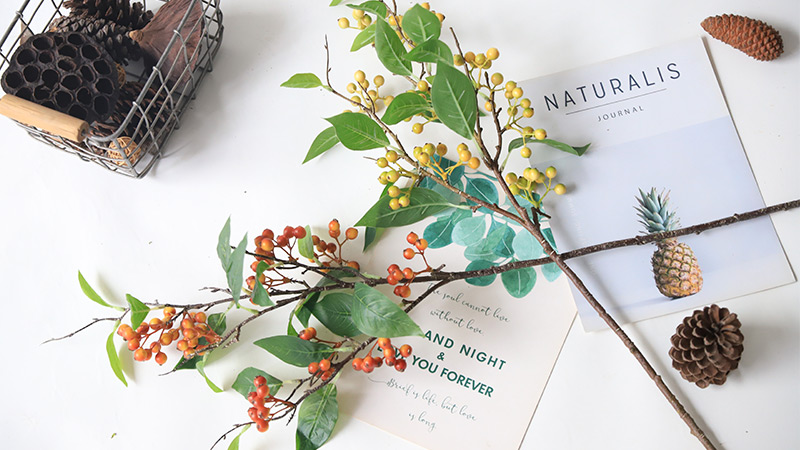Outdoor artificial berries are a game-changer for landscapers, retailers, and designers. However, not all are built to withstand the elements. Low-quality options fade, crack, and deteriorate quickly, costing businesses time and money. So, how can you make the right choice?
Artificial berries for outdoor use must be UV-resistant, weatherproof, and made from durable materials like PU or PE1. Wholesale buyers should assess color retention, material composition, and supplier credibility before purchasing.
Understanding these key factors helps businesses avoid frequent replacements and maintain stunning outdoor displays year-round. Let’s explore how to choose the best artificial berries for outdoor applications.
Key Features of Outdoor Artificial Berries
Not all artificial berries are made the same. Indoor varieties often lack the resilience needed for outdoor conditions.
Essential Features:
- UV resistance – Prevents fading under direct sunlight with UV-treated coatings2.
- Weatherproof materials – Resists rain, wind, and temperature fluctuations.
- Flexible stems – Allows natural movement and easier installation.
- Non-toxic coatings – Ensures safety for commercial use.
Materials Matter: PU vs. PE vs. Silk
| Material | Durability | Weather Resistance | Best Use |
|---|---|---|---|
| PE (Polyethylene) | High | Excellent | Outdoor displays, landscapes |
| PU (Polyurethane) | Medium | Good | Outdoor decorative accents |
| Silk | Low | Poor | Indoor displays only |
True or False?
Are all artificial berries UV-resistant?False
Most budget options lack UV protection, leading to fading and cracking. Always check for
UV-treated coatings[2].
Common Challenges in Outdoor Use and How to Overcome Them
Even the best artificial berries face environmental stress.
Challenges:
- Sun Fading – Prolonged sun exposure causes color loss.
- Water Damage – Non-waterproof coatings may peel.
- Brittleness in Cold Weather – Some materials crack in low temperatures.
Solutions to These Issues
- Choose UV-treated varieties3 for sun resistance.
- Opt for waterproof coatings to prevent peeling and mold.
- Select flexible materials that can withstand temperature fluctuations.
Snippet: High-quality artificial berries for outdoor use should be UV-resistant, waterproof, and flexible to endure weather extremes. Wholesale buyers must prioritize material selection and supplier reliability.

How to Choose the Right Supplier
A reliable supplier makes all the difference. Here’s what wholesale buyers should check:
Supplier Checklist
✔ Material transparency – Are materials clearly listed?
✔ Weather resistance certification – Does the supplier offer test reports?
✔ Customization options – Can they match specific colors or finishes?
✔ MOQ (Minimum Order Quantity) – Does it align with your business needs?
Warning Signs of Low-Quality Products
- Vague material descriptions – Suppliers unwilling to specify materials may use inferior ones.
- No UV testing – If they can’t confirm UV resistance, expect fading.
- Extremely low prices – High-quality materials come at a cost.
Application Ideas for Outdoor Artificial Berries
Artificial berries enhance landscapes, storefronts, and event decor with long-lasting color.
Best Uses
- Landscape Design: Adds year-round vibrancy to gardens.
- Retail Displays: Attracts customers with bold, natural-looking accents.
- Seasonal Décor: Ideal for Christmas, autumn, and wedding arrangements.
Creative Installation Tips
- Blend with natural greenery for a realistic look.
- Use UV-resistant floral foam for durability in outdoor displays.
- Rotate arrangements seasonally to refresh designs without extra cost.
Conclusion
Wholesale buyers should prioritize UV resistance, waterproof materials, and supplier credibility when purchasing artificial berries for outdoor use. Investing in quality ensures longevity, reducing replacement costs and maintaining aesthetic appeal in any outdoor setting.
-
Explanation: To support the claim that PU and PE are the best materials for outdoor artificial plants. ↩
-
Explanation: This link should provide authoritative information about UV protection for artificial plants. ↩
-
Explanation: This link should offer practical steps to prevent sun fading in artificial plants. ↩

Hello everyone, I'm Li!By day, I'm a seasoned expert in the artificial plant industry, starting from the factory floor and working my way up to running my own successful business. In my free time, I’m passionate about running and often join trail runs with friends.Here to share what I've learned—let's grow together!



